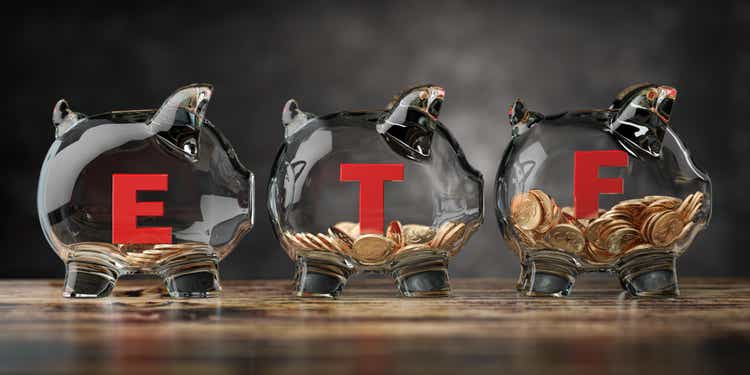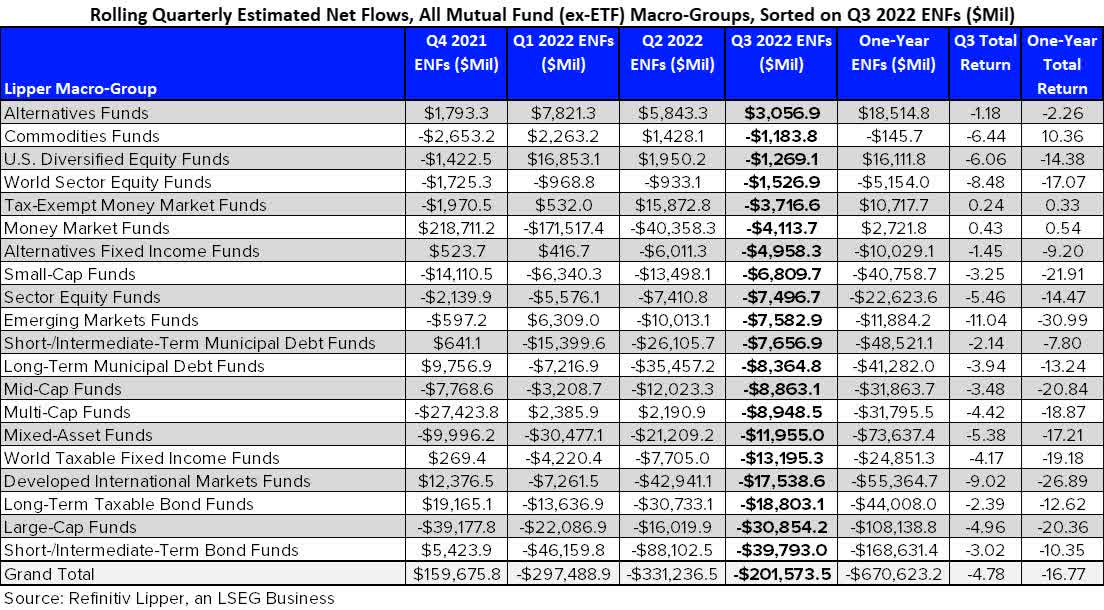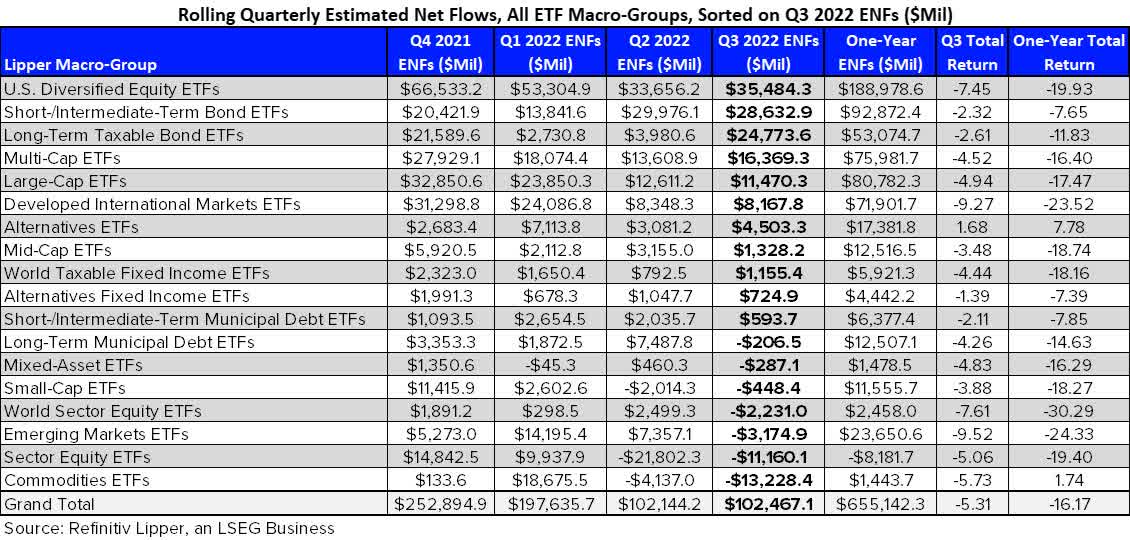Bet_Noire
Assets under management for the U.S. fund business (including conventional funds and ETFs) fell by a combined $1.390 trillion in Q3 2022. However, the lion’s share of those declines can be attributed to performance rather than net outflows.
After the third consecutive 75-basis point (bps) interest rate hike, rising inflationary concerns, growing fears of a recession, an unwavering commitment by the Federal Reserve to tame inflation, and an emerging European energy crisis related to Russia’s war in Ukraine, equity and fixed income securities once again suffered sharp declines during the quarter, with equity mutual funds posting their worst September returns since 2011.
For Q3 2022, the average equity and fixed income fund suffered a 5.89% and 2.42% loss, respectively, bringing the year-to-date drubbing to a disappointing 23.47% and 10.59% respective decline.
For the quarter, conventional mutual funds witnessed net outflows to the tune of $201.6 billion—lower than the prior two quarters—with the alternative funds macro group (+$3.1 billion) attracting the only net new money of Refinitiv Lipper’s mutual funds and ETFs macro groups. The short-/intermediate-term bond funds and large-cap growths funds macro groups witnessed the largest net redemptions, handing back $39.8 billion and $30.9 billion, respectively.

The individual classifications comprising the money market funds macro group (-$4.1 billion) witnessed the three largest net inflows and outflows for Q3. The Money Market Funds (+$87.8 billion), U.S. Treasury Money Market Funds (+$16.7 billion), and Institutional Money Market Funds (+$8.2 billion) classifications took in the largest net inflows of any open-end fund (ex-ETFs) classifications, while Institutional U.S. Government Money Market Funds (-$60.0 billion), Institutional U.S. Treasury Money Market Funds (-$32.2 billion), and U.S. Government Money Market Funds (-$24.6 billion) suffered the largest net redemptions.
Ignoring the money market fund classifications, the International Multi-Cap Core Funds (+$7.8 billion) and General Bond Funds (+$7.7 billion) classifications took in the largest net inflows, while Large-Cap Growth Funds (-$20.2 billion) and Short Investment-Grade Debt Funds (-$15.1 billion) suffered the largest net outflows.

While conventional funds suffered net redemptions for Q3, their ETF counterparts once again attracted net new money, taking in $102.5 billion for the three-month period ended September 30, 2022. The U.S. Diversified Equity (USDE) ETF (+$35.5 billion) macro group attracted the largest amount of investors’ assets for the quarter, followed by short-/intermediate-term bond ETFs (+$28.6 billion) and long-term taxable bond ETFs (+$24.8 billion), while the commodities ETFs (-$13.2 billion), sector equity ETFs (-$11.2 billion), and emerging markets ETFs (-$3.2 billion) macro groups handed back the largest sums of money for Q3.

Despite the 10-year Treasury yield rising 85 bps during the third quarter settling at 3.83% on September 30—after hitting a quarterly high of 3.97% on September 27, and the two-year Treasury yield climbing 130 bps for Q3, settling at 4.22% at month end—investors pumped the largest amounts of net new money for the quarter into General U.S Treasury ETFs (+$22.2 billion) and Short U.S. Treasury ETFs (+$16.5 billion) as investors ducked for cover and perhaps had hope that the Federal Reserve will become more dovish in the months ahead.
And with front-month gold future prices declining 7.85% for the quarter, along with the United Kingdom’s leadership issues coming to the forefront at quarter-end, it wasn’t too surprising to see the Commodities Precious Metals ETFs (-$9.6 billion) and European Region ETFs (-$4.4 billion) classifications suffering the largest net redemptions in the ETF classifications for Q3.

The Vanguard 500 Index ETF (VOO, +$10.8 billion) benefitted from investors’ search for large-cap issues with strong balance sheets and relative yields during the quarter, attracting the largest sum of net new money of all ETFs, followed by iShares 20+ Year Treasury Bond ETF (TLT, +$7.0 billion), Vanguard Total Stock Market Index ETF (VTI, +$6.8 billion), and iShares U.S. Treasury Bond ETF (GOVT, +$5.8 billion).
At the bottom of the ETF pile, iShares Gold Trust (GLD, -$6.1 billion), iShares Russell 2000 ETF (IWM, -$2.8 billion), and iShares MSCI Emerging Markets ETF (EEM, -$2.2 billion) suffered the largest net redemptions for Q3.
While for the quarter passively managed funds (including conventional funds and ETFs, +$116.4 billion) outdrew their actively managed brethren (-$215.5 billion), we saw that actively managed responsible investment (RI) funds (+$4.4 billion, excluding money market funds) attracted more net new money for the quarter than their passively managed RI cohorts (+$1.4 billion).

The stickiness for actively managed RI funds was primarily seen in the taxable fixed income asset group (+$7.4 billion). That said, passively managed RI funds witnessed net inflows in each of the broad asset groups, while actively managed RI funds saw net redemptions in the domestic equity (-$2.6 billion), world equity (-$282 million), and mixed-assets (-$106 million) funds asset groups.
Editor’s Note: The summary bullets for this article were chosen by Seeking Alpha editors.


Be the first to comment